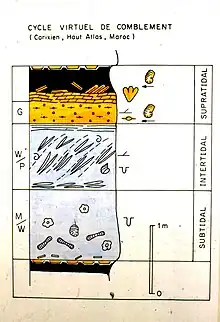| Aganane Formation | |
|---|---|
| Stratigraphic range: Lower-Late Pliensbachian ~ | |
 Autocyclic filling sequences in the Middle Liassic lagoon, South Todhra | |
| Type | Geological formation |
| Unit of | High Atlas |
| Underlies |
|
| Overlies |
|
| Lithology | |
| Primary | Limestone, dolomite |
| Other | Sandstones, Claystone, Shale, Conglomerate |
| Location | |
| Coordinates | 31°36′N 6°24′W / 31.6°N 6.4°W |
| Approximate paleocoordinates | 25°54′N 4°18′W / 25.9°N 4.3°W |
| Region | Central High Atlas |
| Country | |
| Type section | |
| Named for | Aganane Village, near Tizouggaghiyn |
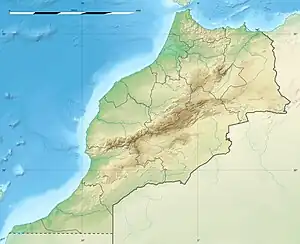 Aganane Formation (Morocco) | |
The Aganane Formation is a Pliensbachian (Early Jurassic) geologic formation in the Azilal, Béni-Mellal, Ouarzazate, Tinerhir and Errachidia provinces, central Morocco, being the remnant of a local massive Carbonate platform, and known mostly for its rich tracksites (up to 1350 tracks in 1988) including footprints of thyreophoran, sauropod and theropod dinosaurs.[1] This formation has been dated to the Pliensbachian stage of the Lower Jurassic, thanks to the find of the ammonite Arieticeras cf. algovianum, indicator of Middle Domerian (=Uppermost Pliensbachian) in the upper zone, and lower delimitation by the foraminifers Mayncina termieri and Orbitopsella praecursor (indicators of Carixian=Lower Pliensbachian age).[2] The dinosaur tracksites are all located a few metres below the Pliensbachian-Toarcian limit, being coeval and connected with the lowermost layers of the continental Azilal Formation. The Aganane Formation was also coeval with the Jbel Taguendouft Formation and the Tamadout 1 Formation, all developed along a local "platform-furrow" in the Middle Atlas Mountains, that act as a barrier controlling the western border of the Jurassic Atlas Gulf.[3] The nearshore sections, including both carbonate platforms and close to sea terrestrial facies where located on an isolated internal domain thanks to the control of the barrier, allowing the Aganane Formation to develop on a hot and humid climate, where a local algal marsh had intermittent progradations, intercalated with a layer of terrigenous continental origin.[3] The ichnosites were developed in tidal flats and coastal deposits suitable to sea flooding.[4]
The Aganane Formation is a member of the Pliensbachian facies section of the Central Atlas, which are distributed from west to east: The Aït Chitachen Formation at Demnate (continental-fluvial, coastal lagoon), the Aganane itself at Azilal.[4] At Tazoult, part of the Azilal profile contacts the bottom with the karst Talmest-Tazoult Formation, then a section where the Aganane itself indicates an eastward expansion of the carbonate facies, finally, the most recent Pliensbachian strata belong to the Amezraï Formation (Intertidal to coastal marine), this last change being the result of a transgression where we see a westward advance of the Imilchil pelagic facies.[4]
At Tazoult, the presence of a Diapir (the Tazoult salt wall) is remarkable. In the Pliensbachian, this area begins with the deposition of the Talmest-Tazoult Formation, and then is invaded from the west by the shallow marine carbonate platform of the Aganane Formation.[5] At this time, a decrease in the growth rate of the diapir is detected compared to the Sinemurian. In fact, with the eastward extension of the Aganane Formation, the Tazoult salt wall registers a major change towards shallower facies, confirming a higher diapir relief and a decrease in water depth towards this area during the Pliensbachian, not excluding a complete stop of diapir activity in this interval.[5]
Paleoenvironment
The Aganane Formation is characterized as representing a carbonate platform, the most important Lower Jurassic platform in the central High Atlas, bounded to the west at Demnat by the Aït Chitachen Formation, which represents environments ranging from fluvial to coastal lagoons, with palynological residues Corollina quezelii & Corollina yvesi (Cheirolepidiaceae) as dominant, indicating an arid environment, accompanied by Cupressacites oxycedroides & Diadocupressacites moghrebiensis, both palynological residues of Cupressaceae.[6]
The Carbonates of this unit were subjected to an examination of the diagenetic characteristics of the carbonates, allowing the construction of a model of diagenetic environments, where changes in the surface environment were consistently reflected in a sequence of rocks by diagenetic characteristics, maybe a tentative correlation of major events, such as Hurricanes.[7] The carbonate rocks that form the massive "Aganane Platform" are clearly influenced by tidal and shallow marine flows, ascribed to three environments: supratidal, intertidal and subtidal.[8] The supratidal sector is diverse, including continental deposits with abundant quartz-rich cricundant deposits and fluvial channels, as well as others composed of considerable thicknesses of stratified gypsum and chicken-wire cargneules, lime and dolomite shales and marls, with drying cracks, caliche crusts and vadose pisoliths. These sediments suggest a continental zone bordering river courses, connected to coastal sectors where shales and siltstones derived from Sabkhas in which interstitial evaporites were formed.[9][10] Intertidal deposits are composed of algal laminates, bioturbated pelletiferous shales, uniformitarian shales and wackestones with disruptive channels and storm sequences. Algal laminated Boundstones developed in both supratidal and intertidal zones, following present-day patterns such as Shark Bay in Australia or the Persian Gulf. Whereas the pelletoid lime packstone/wackestone facies most likely represented tidal flat areas, or analogs to modern coastal mangrove growth.[9][10] Subtidal deposits include both those of an intertidal nature, indicating shallow water or coastal lagoons, with extensive accumulations of skeletal lime packstones, oolitic tidal deltas and offshore bars, oncoliths and coral reefs, and occasional Opisoma spp. While further east the more open subtidal conditions are represented by flint-bearing calcareous shales and sparse faunas where ammonites begin to appear.[9][10]
.jpg.webp)
The Carbonate Facies of the High Atlas "Middle Lias" (Pliensbachian) generally have a low bathymetry. They show a notable evolution from east to west from a lagoon-marine facies to brackish facies. At the level of the Azilal Atlas, the Middle Lias occurs on both sides of the Demnat Fault: to the southwest of the fault, the Aït Bazzi Formation with dolomitic and red marly facies (lagoonal and lagoon-evaporitic facies), while to the northeast develop the thicker facies of the Aganane Formation.[11] In this area, formations of this stage begin either with conglomeratic facies associated with red marls or with scree and conglomerates associated with local erosion, recovering the same lower Pliensbachian emersion phase observed in the Beni-Mellal Atlas.[11] Toward the south, the "basin" facies ends at the bottom of the gulf near the Jbel Oukarde accident, at the western end of the Tilougguit syncline. The southern limit of this basin, hidden by the later sediments, corresponds to the present-day course of the Azilal-Anergui submeridian fault. Toward the south, on the Amezraï and Aït Bouguemmez basins, a platform zone was established in the heart of the Central High Atlas, consisting of the Jbel Choucht, Aganane, Assemsouk, and Amezraï formations.[11] The Jbel Choucht Formation is the type locality here, characterized by a great development of coralligenous facies. The Jbel Choucht Formation is also present towards the north-central High Atlas, but without any reef character, being rather rich in megalodont bivalves, while the Aganane Formation presents more or less the same characteristics as those described in the Beni-Mellal Platform. To the east, at the level of the Jbel Aroudane, the thickening and sedimentary polarity of the Jbel Choucht Formation occurs this time southward, with a W-E subsident basin centered on the Jbel Azourki and the Jbel Aroudane.[11]
In the Aganane Formation towards terminal Carixian (Lias biozone C2 in the High Atlas of Morocco) several sedimentary environments are distinguished in the carbonate inner platform. These environments are characterized by rhythmic sedimentation composed of metric sedimentary sequences analogous to present-day "marnières".[12] Lithologically, there are two juxtaposed sedimentary units that represent two types of complex environments: a first assemblage that includes the marlodolomitic unit of the Aganane Formation and the Aït Bazzi Formation; these units are also equivalent to lagoonal and lagoon-evaporitic facies.[12] This sedimentary assemblage corresponds to a carbonate supratidal coastal plain environment regularly overlain by red marl deposits of continental origin, which can be compared to the modern Sabkhas in the Persian Gulf, but in a less arid climatic context, for the frequent presence of dinosaur tracks suggests extensive vegetation cover in the hinterland, and thus high annual precipitation, suggesting overall tropical conditions reminiscent of the Andros Island model in the Bahamas.[12] A second set (a light gray limestone-dolomite subunit) more distal to the inner platform, in which the environment varies, repeatedly, from subtidal to supratidal conditions, from marine to coastal plain deposits, sometimes showing red terrigenous intercalations, revealing the presence of local cycles evolving from temporary lagoon to "sabkha", while in the outermost part of the platform the existence of a permanent lagoon can be assumed.[13] The facies of this lagoon are muddy and highly bioturbated, with numerous marine organisms colonizing the soft substrate of the lagoon: Lamellibranchs, Gastropods, Brachiopods, with calcareous algae (Palaeodasycladus, Solenopores, etc.) oncoliths and Foraminifers. These levels with large Lamellibranchs (especially "Lithiotidae") are rather rare in the Carixian.[12]
Locations such as Ait Athmane recover the typical Sinemurian-Pliensbachian mediterranean lithiotid bivalve reefs, composed by aggrupation of aberrant bivalves.[14] These "Reefs" had a strong zonation, starting with the bivalves Gervilleioperna and Mytiloperna, restricted to intertidal and shallow-subtidal facies. Lithioperna is limited to lagoonal subtidal facies and even in some low-oxygen environments. Finally Lithiotis and Cochlearites are found in subtidal facies, constructing buildups.[15] Locally, these reefs were developed as shallow subtidal, cross-bedded floatstones, later evolving to layers with evidence of subaerial exposure, including lagoonal marls, and bioturbated red mudstones with root traces and calcrete.[14] These layers are abundant on the aberrant bivalves Lithioperna and Cochlearites, as well common corals, gastropods, the bivalve Opisoma and oncoids, all living in a sheltered lagoon in the interior of the local carbonate platform, similar to the Rotzo Formation of the Trento Platform.[14]
At Ait Bou Guemmez, the upper Aganane Formation records the development of a lagoonal environment south of the Jbel Tizal-Jbel Azourki accident, which evolves to a more or less open subtidal platform environment north of this accident.[16] The local transgressive procession is marked by the dominance of subtidal facies with a microfauna of biozone C1, whereas the high marine level procession is represented by a succession of intertidal to supratidal dolomitic limestones, its top is surmounted by an important subaerial discontinuity materialized by red clay with paleosols and abundant plant roots (e.g. at Tizi n'Terghist).[16] In other localities are mainly biodetritic limestones, showing emersion structures at their top (dolomitization, mud cracks, roots and plant remains, footprints of Dinosaurs).[16]
Paleogeography
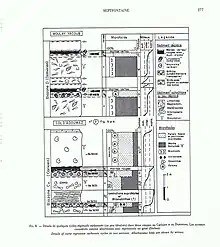
The Aganane Formation is located largely within the "Grand e Accident du Nor d'Altasien" or North Atlas Fault, the largest and most important of the Central High Atlas faults.[10] During the late Pliensbachian, 200 m of carbonate sediments accumulated south of the fault on an overturned block, while to the north more than 700 m of similar material accumulated.[10] This fault line probably marked the northern boundary of a Paleozoic basement peninsula that advanced eastward from the Tichka Massif into the Atlas Trench.[10]
The paleogeographic evolution of our region can be described in three main stages:
- The Lower Pliensbachian ("Carixian"), which follows the typical Sinemurian paleogeographic pattern with foreshores and prolonged emersion facies (paleosols, karsts and teepee-shaped structures), the latter being mainly observed on the southern slopes of the central High Atlas, evolving on the subtidal platform of the Upper Sinemurian, with the "Lithiotidae" colonizing for the first time the main areas located in line with the active accidents, notably the fault located NE-SW, separating the Tilougguit trough to the SE from its limiting platform to the NW.[11]
- The "middle" Pliensbachian ("Carixian" - lower "Domerian") marine environment gradually resettles along the western edge of the High Atlas Basin, with maximum opening of depositional environments in the Carixian-Domerian transition (rhythmic mamocalcic sedimentation in the Tilougguit Trench, turbidite facies on the SE edge of the Beni-Mellal platform and subsident lagoons in the other sectors). At the same time, the NW-SE-trending Demnat Fault and the N70-trending North Atlas Fault become evident, whereas the southern edge of the Telouet Graben does not appear to have changed significantly during the Middle Lias like its counterpart in the northern part of the range, being here the main site of the shallow sedimentation of the Aganane Formation.[11] Towards the Tincghir meridian, open sea facies are encountered.[11]
- The last facies belong to the Upper Pliensbachian (Upper Domerian) where the paleogeography of the Central High Atlas becomes very contrasted, with emersion of a vast sector of the platform (At Demnat), leading to the development of paleosols and karst and the accumulation of lignite deposits along tectonically active faults.[11] At the same time, there is a filling of the Tilougguit ditch by carbonate and terrigenous sedimentation, showing small basins like Tamadout and Taquat N'Agrd with a sedimentation with a gravity component, and shoals (Jbel Taguendouft) with condensed deposits.[11] Finally an intensification of the activity of the North leading to the deepening of the central platform (creation of the new basin of Amezraï), to the individualization of strongly subsident zones in the aplomb of this accident (gutter of Jbel Azourki-Jbel Aroudane) and to the birth of the first wrinkles in the center of the high-Atlasic basin.[11]
Foraminifera
| Genus | Species | Stratigraphic position | Material | Habitat | Notes | Images |
|---|---|---|---|---|---|---|
|
Everticyclammina[17] |
|
|
Calcareous Skeletons |
Marine or Lagoonal |
A foraminifer of the Everticyclamminidae family. It represents a species similar to E. virguliana, known from the Middle Jurassic of Morocco. |
|
|
|
Calcareous Skeletons |
Marine or Lagoonal |
A foraminifer of the Hauraniinae family. |
||
|
Lituosepta[17] |
|
|
Calcareous Skeletons |
Marine or Lagoonal |
A foraminifer of the Mesoendothyridae family. |
|
|
Mayncina[17] |
|
|
Calcareous Skeletons |
Marine or Lagoonal |
A foraminifer of the Nezzazatoidea family. |
|
|
Mesoendothyra[17] |
|
|
Calcareous Skeletons |
Marine or Lagoonal |
A foraminifer of the Mesoendothyridae family. |
|
|
Orbitopsella[17] |
|
|
Calcareous Skeletons |
Marine or Lagoonal |
A foraminifer of the Mesoendothyridae family. |
|
|
Pseudocyclammina[17] |
|
|
Calcareous Skeletons |
Marine or Lagoonal |
A foraminifer of the Pfenderinidae family. |
|
|
Pseudopfenderina[17] |
|
|
Calcareous Skeletons |
Marine or Lagoonal |
A foraminifer of the Pfenderinidae family. |
|
|
Siphovalvulina[17] |
|
|
Calcareous Skeletons |
Marine or Lagoonal |
A foraminifer of the Pfenderinidae family. |
|
Algae
| Genus | Species | Stratigraphic position | Material | Habitat | Notes | Images |
|---|---|---|---|---|---|---|
|
Boueina[12] |
|
|
Calcareous Skeletons |
Marine or Lagoonal |
An alga of the Halimedaceae family. |
|
|
Cayeuxia[17] |
|
|
Calcareous Skeletons |
Marine or Lagoonal |
An alga of the Halimedaceae family. |
|
|
Paleodasycladus[17] |
|
|
Calcareous Skeletons |
Marine or Lagoonal |
An alga of the Dasycladaceae family. |
|
|
Pseudolithocodium[12] |
|
|
Calcareous Skeletons |
Marine or Lagoonal |
An alga of the Thaumatoporellales family. |
|
|
Sestrosphera[17] |
|
|
Calcareous Skeletons |
Marine or Lagoonal |
An alga of the Solenoporaceae family. This genus is the most common algal type found in the Biozone A (Lituosepta recoarensis). |
|
|
Thaumatoporella[17] |
|
|
Calcareous Skeletons |
Marine or Lagoonal |
An alga of the Thaumatoporellales family. |
|
Invertebrata
Ichnofossils
| Genus | Species | Location | Material | Type | Made by | Notes | Images |
|---|---|---|---|---|---|---|---|
|
|
Borrowing Traces |
Domichnia |
|
Marine, brackish, or freshwater Unbranched U-shaped burrows, subvertical in orientation, with or without lining and passive infill. Are common in modern coastal environments. |
 | |
|
Tubular Fodinichnia |
Fodinichnia |
|
Interpreted as the feeding burrow of a sediment-feeding animal. |
|||
|
Tubular Fodinichnia |
Fodinichnia |
|
Burrow-like ichnofossils. Interpreted as the feeding burrow of a sediment-ingesting animal. A more recent study has found that Scoloplos armiger and Heteromastus filiformis, occurring in the German Wadden Sea in the lower parts of tidal flats, make burrows that are homonymous with numerous trace fossils of the ichnogenus.[18] |
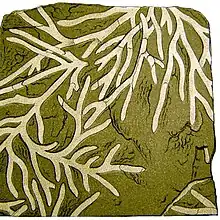 Illustration of Chondrites bollensis | ||
|
Tubular Fodinichnia |
Domichnia and/or fodinichnia. |
|
Dwelling and feeding burrow of a suspension-feeder or deposit-feeder, associated usually with shallow waters |
 Specimens | ||
|
Cylindrical to subcylindrical burrows |
Domichnia |
|
Burrow-like ichnofossils made by organisms advancing along the bottom surface. Very narrow, vertical or subvertical, slightly winding unlined shafts filled with mud. Interpreted as dwelling structures of vermiform animals; specifically, the domichnion of a suspension-feeding worm or phoronidans |
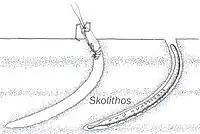 Skolithos ichnofosil reconstruction, with possible fauna associated | ||
|
Tubular Fodinichnia |
Fodinichnia |
|
Burrow-like ichnofossils. Large burrow-systems consisting of smooth-walled, essentially cylindrical components. Common sedimentary features are Thalassinoides trace fossils in the fissile marlstone to claystone intervals |
 Thalassinoides burrowing structures, with modern related fauna, showing the ecological convergence and the variety of animals that left this Ichnogenus. | ||
|
Dwelling traces |
Domichnia & Fodinichnia |
Burrow-like ichnofossils. It has been related to Echiurans, but also from moving and feeding polychaete worms. |
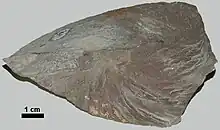 Example of Zoophycos fossil | |||
Anthozoa
| Genus | Species | Stratigraphic Position | Material | Notes | Images |
|---|---|---|---|---|---|
|
Ampakabastraea[14] |
|
|
Calcified skeleton pieces |
A Coral of the family Stylinidae. |
|
|
Archaeosmilia[14] |
|
|
Calcified skeleton pieces |
A Coral of the family Zardinophyllidae. Late Pliensbachian corals of the Aganane Formation are mainly limited to Retiophyllia, Thamnasteria and Archaeosmilia. |
|
|
Archaeosmiliopsis[14] |
|
|
Calcified skeleton pieces |
A Coral of the family Archaeosmiliidae. |
|
|
Oppelismilia[19] |
|
|
Calcified skeleton pieces |
A Coral of the family Oppelismiliidae. |
|
|
Phacelostylophyllum[19] |
|
|
Calcified skeleton pieces |
A Coral of the family Stylophyllidae. |
|
|
Phacelophyllia[19] |
|
|
Calcified skeleton pieces |
A Coral of the family Dermosmiliidae. |
|
|
Periseris[19] |
|
|
Calcified skeleton pieces |
A Coral of the family Latomeandridae. |
|
|
Retiophyllia[14] |
|
|
Calcified skeleton pieces |
A coral of the family Reimaniphylliidae. The phaceloid genus at this site is similar to the common Triassic genus Retiophyllia. |
|
|
|
Calcified skeleton pieces |
A coral of the family Thamnasteriidae. |
||
Demospongea
| Genus | Species | Stratigraphic position | Material | Notes | Images | |
|---|---|---|---|---|---|---|
|
Cladocoropsis[12] |
|
|
Calcareous Skeleton |
Marine or Lagoonal |
A sponge of the family Cladocoropsidae. Fossils of this and other unidentified sponges are commonly found in reef deposits, associated with corals. |
|
Crustacea
| Genus | Species | Stratigraphic position | Material | Habitat | Notes | Images |
|---|---|---|---|---|---|---|
|
Parafavreina[12] |
|
|
Coprolites |
Marine, Tidal Flat or Lagoon |
Crustacean fossil coprolites, assigned to the ichnofamily Favreinidae. Crustacean coprolites are most abundant in lagoonal deposits, where they are associated with reefs. Possibly coprolites of Thalassinidea |
 |
Brachiopoda
| Genus | Species | Stratigraphic position | Material | Notes | Images |
|---|---|---|---|---|---|
|
Calcirhynchia[20] |
|
|
Isolated Shells |
A Brachiopodan of the family Cirpinae. Relatively abundant on seashore deposits. It was originally identified as part of the genus Rhynchonella |
|
|
Hesperithyris[20] |
|
|
Isolated Shells |
A Brachiopodan of the family Zeilleriidae |
|
|
|
Isolated Shells |
A Brachiopodan of the family Spiriferinidae |
||
|
Tauromenia[20] |
|
|
Isolated Shells |
A Brachiopodan of the family Zeilleriidae |
|
Bivalves
| Genus | Species | Stratigraphic position | Material | Notes | Images |
|---|---|---|---|---|---|
|
|
Isolated Shells |
A saltwater bivalve of the family Mytilidae. |
||
|
|
Isolated Shells |
A saltwater bivalve of the family Pterioida. A large bivalve, with a subequal shell, that can reach 60–70 cm in height. It is one of the three principal bivalves found on the Lithiotis facies, whose accumulations generally cover megalodontid coquinas. |
||
|
|
Isolated Shells |
A saltwater/brackish bivalve of the family Neomiodontidae. This genus is considered an opportunistic suspension feeder of shallow infauna, and the marker genus for brackish environments.[23] |
||
|
|
Isolated Shells |
A saltwater bivalve of the family Lucinidae. |
.png.webp) | |
|
Gervilleia[20] |
|
|
Isolated Shells |
A saltwater bivalve of the family Bakevelliidae. |
|
|
|
Isolated Shells |
A saltwater bivalve of the family Malleidae. Abundant along the rootlets, indicating a very shallow and restricted lagoon or swamp environment |
||
|
|
Isolated Shells |
A saltwater bivalve of the family Gryphaeidae. This genus develops a noted material oyster biostrome at Aït Athmane, where a discontinuous, patchy layer is formed, developed under submarine lithification and a relative enrichment in terrigenous matter.[24] |
 | |
|
|
Isolated Shells |
A saltwater bivalve of the family Pterioida. This genus was founded to be a bivalve with a juvenile byssate stage that developed different lifestyles in adulthood depending on the density of individuals and the firmness of the bottom |
||
|
|
Isolated Shells |
A saltwater/brackish bivalve of the family Lucinidae. Linked with intertidal settings |
 | |
|
|
Isolated Shells |
A saltwater bivalve of the family Malleidae |
||
|
|
Isolated Shells |
A saltwater/brackish bivalve of the family Astartidae. Is considered a genus that evolved from shallow burrowing ancestors, secondarily becoming an edge-lying semi-fauna adapted to photosymbiosis.[25] In the Aganane Formation, this genus is both associated with Corallinaceous facies and tidal flats, even recovered on intertidal channels similar to the ones recovered on modern mangroves |
||
|
|
Isolated Shells |
A saltwater bivalve of the family Pachyrismatidae |
||
|
|
Isolated Shells |
A saltwater bivalve of the family Pectinoidae |
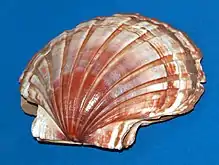 | |
|
|
Isolated Shells |
A saltwater bivalve of the family Pholadomyidae |
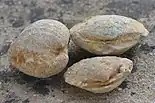 | |
|
|
Isolated Shells |
A saltwater bivalve of the family Pachyrismatidae |
||
Gastropoda
| Genus | Species | Stratigraphic position | Material | Notes | Images |
|---|---|---|---|---|---|
|
|
Isolated Shells |
A saltwater gastropod of the family Nerineidae. Local specimens appear to have algal material on the shells, indicating a restricted lagoon environment. |
.JPG.webp) | |
|
Pseudonerinea[20] |
|
|
Isolated Shells |
A saltwater gastropod of the family Nerineidae |
|
|
|
Isolated Shells |
A saltwater gastropod of the family Nerineidae. "Scurria" was found in the Assemsouk structure on a "Cochlearites" valve and a shallow ovoid excavation, similar to the resting trace of a limpet, was found inside a transported "Lithiotis". |
 | |
Ammonites
| Genus | Species | Stratigraphic position | Material | Notes | Images |
|---|---|---|---|---|---|
|
|
Isolated Shells |
An ammonite of the family Hildoceratidae. Arieticeras cf. algovianum is indicative of the Middle Domerian (Upper Pliensbachian) in the upper zone |
||
|
|
Isolated Shells |
An ammonite of the family Hildoceratidae |
||
|
Seguenziceras[2] |
|
|
Isolated Shells |
An ammonite of the family Polymorphitidae |
|
|
Tropidoceras[2] |
|
|
Isolated Shells |
An ammonite of the family Polymorphitidae |
|
|
|
Isolated Shells |
An ammonite of the family Polymorphitidae |
 | |
Annelida
| Genus | Species | Stratigraphic position | Material | Habitat | Notes | Images |
|---|---|---|---|---|---|---|
|
Indeterminate |
|
Calcareous skeleton |
Marine or Lagoonal |
A Sabellida of the family Serpulidae. These annelids are found as well in the reef facies as in the lagoon deposits |
 | |
Dinosaur Tracks
Theropoda
| Genus | Species | Stratigraphic position | Material | Notes | Images |
|---|---|---|---|---|---|
|
|
Footprints |
Traces of theropods, members of the ichnofamily Anchisauripodidae, incertae sedis within Neotheropoda. Attributed to dinosaurs of type Coelophysidae |
 The prints of Anchisauripus belong to a genus similar to that of Procompsognathus | |
|
|
Footprints |
Theropod tracks, member of the ichnofamily Anchisauripodidae, incertae sedis inside Neotheropoda. Mistaken originally as coelurosaur tracks, this specimens have pes that resemble those of Noasaurids and other Abelisauroids.[28] Includes a pathologic trackway with evidence of limping, as well three morphotypes: Didactyl, tridactyl and tetradactyl theropod trackways.[1] |
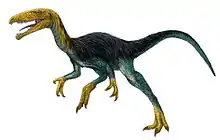 The footprints of Argoides belong to a genus with a pes similar to Velocisaurus, yet does not implicate is a member of the family or a relative | |
|
|
Footprints |
Theropod tracks, member of the ichnofamily Eubrontidae, incertae sedis inside Theropoda. Ceratosaur tracks. Includes the largest theropod track from the Early Jurassic of Morocco.[28] |
 The footprints of Carmelopodus belong to a genus with a pes similar to Ceratosaurus, yet does not implicate is a member of the family or a relative | |
|
|
Footprints |
Theropod tracks, type member of the ichnofamily Eubrontidae, incertae sedis inside Theropoda. Eubrontes is related to the Genus Dilophosaurus, representing a basal Neotheropods. |
 | |
|
|
Footprints |
Theropod tracks, typical member of the ichnofamily Grallatoridae, incertae sedis within Theropoda. Attributed to dinosaurs of type Coelophysidae and Dilophosaurus |
 | |
|
|
Footprints |
Traces of theropods, members of the ichnofiber family Eubrontidae, incertae sedis within Theropoda. Traces of tetanurans, some with a resemblance to Allosauroids.[28] |
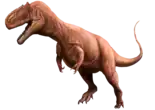 The footprints of Megalosauripus belong to a genus with a pes similar to Allosaurus, yet does not implicate is a member of the family or a relative | |
|
|
Footprints |
Traces of theropods, members of the ichnofamily Anchisauripodidae, incertae sedis within Neotheropoda. Theropods with bird-like legs or similar to that of Coelurosaurs |
||
|
|
Footprints |
Theropod Tracks of uncertain affinity |
||
Sauropodomorpha
| Genus | Species | Stratigraphic position | Material | Notes | Images |
|---|---|---|---|---|---|
|
|
Footprints |
Traces of sauropods, typical member of the ichnofamily Parabrontopodidae, incertae sedis within Sauropodomorpha. Includes traces with pes similar to Diplodocoidea.[31][32] |
 The footprints of Breviparopus belong to a genus with a similar pes to that of Amphicoelias, yet it doesn´t mean is from a Neosauropod | |
|
|
Footprints |
Traces of sauropods, typical member of the ichnofamily Parabrontopodidae, incertae sedis within Sauropodomorpha. Includes traces with pes similar to those of Blikanasaurus.[32] |
 | |
|
|
Footprints |
Traces of sauropodomorphs, a type member of the ichnofamily Otozoidae, incertae sedis within Sauropodomorpha. Includes a gigantic 84 or 75 cm track that represents the largest Otozoum ever described in the literature.[34] |
 The local Footprints of Otozoum may have belonged to a genus similar to that of Lamplughsaura | |
|
|
Footprints |
Traces of sauropods, typical member of the ichnofamily Parabrontopodidae, incertae sedis within Sauropodomorpha. Includes tracks with pes similar to those of Vulcanodon (perhaps left by Tazoudasaurus?) and other morphotype more similar to Rhoetosaurus.[32] |
 The Footprints of Parabrontopodus may have belonged to a genus similar to that of Vulcanodon | |
|
|
Footprints |
Traces of sauropodomorphs, a type member of the ichnofamily Otozoidae, incertae sedis within Sauropodomorpha. |
 The prints of Pseudotetrasauropus may have belonged to a genus similar to that of Leonerasaurus | |
|
|
Footprints |
Sauropodomorph tracks of uncertain affinity |
||
|
|
Footprints |
Sauropod tracks of uncertain affinity |
 Metric tracks of a giant sauropod dinosaur, at the top of an emersive "shallowing upward" carbonate cycle | |
Ornithischia
| Genus | Species | Location | Material | Notes | Images |
|---|---|---|---|---|---|
|
|
Footprints |
Thyreophoran tracks, type member of the ichnofamily Moyenisauropodidae, incertae sedis inside Neornithischia. Is considered synonymous with the ichnogenus Anomoepus. The tracks adscribed resemble basal Thyreorphora feet. The tracks related to the genus are vinculated with genera such as Scelidosaurus, whose fossils have been found on Pliensbachian strata of England. Due to it´s morphology, this tracks have been latter identified as possible Deltapodus, yet this does not mean they are of Stegosaur origin.[36] |
 Scelidosaurus, one of the best known Early Jurassic Thyreophorans, matches with the bodyplan assigned to the ichnogenus Moyenisauropus | |
Photo Gallery
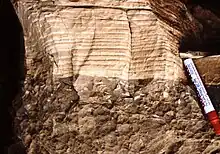 Metric emersive cycle in the carbonate platform. Deposition of marine lagoon with foraminifera then dolomitized algal laminations in intertidal to supratidal environment.
Metric emersive cycle in the carbonate platform. Deposition of marine lagoon with foraminifera then dolomitized algal laminations in intertidal to supratidal environment.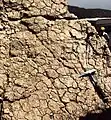 Desiccation cracks on the surface of a dolomitized limestone bench, metric emersive cycle top of the Liassic Platform Lagoon.
Desiccation cracks on the surface of a dolomitized limestone bench, metric emersive cycle top of the Liassic Platform Lagoon. Ammonites and belemnites displaced on the supratidal plain ("teepee") by a storm wave or a tidal current
Ammonites and belemnites displaced on the supratidal plain ("teepee") by a storm wave or a tidal current Storm breach at the top of a metric regressive sequence.
Storm breach at the top of a metric regressive sequence. Vadose pisoliths and "birdseyes" in coastal carbonate sand, emergent; outer shelf.
Vadose pisoliths and "birdseyes" in coastal carbonate sand, emergent; outer shelf. Aerial, supratidal (vadose) diagenesis in a carbonate sand with foraminifera displaced by tidal currents and storm waves on the shelf.
Aerial, supratidal (vadose) diagenesis in a carbonate sand with foraminifera displaced by tidal currents and storm waves on the shelf. Thin layer: calcretes (calcareous crusts) reworked in a gravelly coastal sediment, partly dolomitized.
Thin layer: calcretes (calcareous crusts) reworked in a gravelly coastal sediment, partly dolomitized. Stalactite cement at the top of a "keystone vug" typical of diagenesis in a vadose environment, at the top of an emersive cycle (L=0.3 mm).
Stalactite cement at the top of a "keystone vug" typical of diagenesis in a vadose environment, at the top of an emersive cycle (L=0.3 mm). Calcretes (calcareous crust) and "birdseyes" in a gravelly coastal sediment.
Calcretes (calcareous crust) and "birdseyes" in a gravelly coastal sediment. Diagenetic structure in "teepee" on the supratidal plain, formed by the increase in volume of the sediment following the crystallization of carbonates (dolomite).
Diagenetic structure in "teepee" on the supratidal plain, formed by the increase in volume of the sediment following the crystallization of carbonates (dolomite).
See also
References
- 1 2 3 4 5 6 7 Ishigaki, Shinobu; Lockley, Martin G. (March 2010). "Didactyl, tridactyl and tetradactyl theropod trackways from the Lower Jurassic of Morocco: evidence of limping, labouring and other irregular gaits". Historical Biology. 22 (1–3): 100–108. doi:10.1080/08912961003789867. ISSN 0891-2963. S2CID 129632881.
- 1 2 3 4 5 6 Dubar, G.; Mouterde, R. (1978). "Les formations à ammonites du Lias Moyen dans Ie Hapt Atlas du Midelt et du Tadla". Notes & M. Servo Geo/. Maroc. 274 (4): 77.
- 1 2 Michard, A. (March 2011). "Nouveaux guides géologiques et miniers du Maroc/New Geological and Mining Guidebooks of Morocco, volume 7: Haut Atlas occidental, Haut Atlas central nord-ouest". Notes & M. Servo Geo/. Maroc. 562 (1–3): 70–76. Retrieved 1 April 2022.
- 1 2 3 Jossen, J.A. (1988). "Carte geologique du Maroc au 11100 000: Feuille Zawyat Ahancal". Notes & M. Servo Geo/. Maroc. 335 (4): 23–31.
- 1 2 Martín, J. D.; Vergés, J.; Saura, E.; Moragas, M.; Messenger, G.; Barqués, V.; Hunt, D.W. (2017). "Diapiric growth within an Early Jurassic rift basin: The Tazoult salt wall (central High Atlas, Morocco)". Basin Research. 36 (1): 2–32. Bibcode:2017Tecto..36....2M. doi:10.1002/2016TC004300. hdl:10261/142474. S2CID 3619386. Retrieved January 25, 2022..
- ↑ Courtinat, B.; Le Barrec, A. (1986). "Nouvelles donnees palynologiques sur les "Coaches Rouges" (Jurassique Moyen) de la Region de Demnat (Haut-Atlas,Moroc)" (PDF). Bulletin de l'Institut Scientifique, Rabat. 10 (2): 15–20. Retrieved 21 April 2022..
- ↑ Burgess, C. J. (1979). "The development of a Lower Jurassic carbonate tidal flat, central High Atlas, Morocco; 2, Diagenetic history". Journal of Sedimentary Research. 49 (2): 413–427. Retrieved 20 April 2023.
- ↑ Burgess, C. J.; Lee, C. W. (1978). "The development of a Lower Jurassic carbonate tidal flat, central High Atlas, Morocco; 1, Sedimentary history". Journal of Sedimentary Research. 48 (3): 777–793. Retrieved 20 April 2023.
- 1 2 3 Lee, C. W. (1976). "Facies and Faunistic Variation in the Middle Lias (Domerian) of the Central High Atlas Mountains, Morocco". Thesis University College of Swansea. 1 (1): 331.
- 1 2 3 4 5 6 Lee, C. W.; Burgess, C. J. (1978). "Sedimentation and tectonic controls in the early Jurassic central High Atlas trough, Morocco". Geological Society of America Bulletin. 89 (8): 1199–1204. Bibcode:1978GSAB...89.1199L. doi:10.1130/0016-7606(1978)89<1199:SATCIT>2.0.CO;2. Retrieved 20 April 2023.
- 1 2 3 4 5 6 7 8 9 10 Souhel, A. (1996). "The Mesozoic in the High Atlas of Beni-Mellal (Morocco). Stratigraphy, sedimentology and geodynamic evolution" (PDF). Strata: Series 2, Memoirs. 27 (6): 1–227. Retrieved 12 May 2022..
- 1 2 3 4 5 6 7 8 9 10 11 12 13 14 15 16 Septfontaine, M. (1985). "Environnements de dépôt et foraminifères (Lituolidae) de la plate-forme carbonatée du Lias moyen au Maroc". Revue de Micropaléontologie. 28 (4): 265–289. Retrieved 3 January 2022..
- ↑ Milhi, A.; Ettaki, M.; Chellai, E.H.; Hadri, M. (2002). "The lithostratigraphic formations of moroccan jurassic central High-Atlas: Interelationships and paleogeographic reconstitution". Revue de Paleobiologie. 21 (4): 241–256..
- 1 2 3 4 5 6 7 8 9 10 11 12 Brame, H. M. R.; Martindale, R. C.; Ettinger, N. P.; Debeljak, I.; Vasseur, R.; Lathuilière, B.; Bodin, S. (2019). "Stratigraphic distribution and paleoecological significance of Early Jurassic (Pliensbachian-Toarcian) lithiotid-coral reefal deposits from the Central High Atlas of Morocco". Palaeogeography, Palaeoclimatology, Palaeoecology. 514 (2): 813–837. Bibcode:2019PPP...514..813B. doi:10.1016/j.palaeo.2018.09.001. S2CID 135361516. Retrieved 7 April 2022.
- ↑ Franceschi, M.; Dal Corso, J.; Posenato, R.; Roghi, G.; Masetti, D.; Jenkyns, H.C. (2014). "Early Pliensbachian (Early Jurassic) C-isotope perturbation and the diffusion of the Lithiotis Fauna: Insights from the western Tethys". Palaeogeography, Palaeoclimatology, Palaeoecology. 410 (4): 255–263. Bibcode:2014PPP...410..255F. doi:10.1016/j.palaeo.2014.05.025. Retrieved 3 January 2022.
- 1 2 3 El Bchari, F.; Souhel, A. (2008). "Sequence tratigraphy and geodynamic evolution of the Jurassic (Sinemurian terminal-Aalenian) of Ait Bou Guemmez (Central High Atlas, Morocco)". Estudios Geológicos. 64 (2): 151–160. Retrieved 28 March 2022.
- 1 2 3 4 5 6 7 8 9 10 11 12 13 14 15 16 17 18 19 20 Septfontaine, H. M. R. (1984). "Biozonation (a l'aide des foraminifères imperfores) de la plate-forme interne carbonatée liasique du Haut Atlas (Maroc)". Revue de Micropaléontologie. 27 (3): 209–229. Bibcode:2019PPP...514..813B. doi:10.1016/j.palaeo.2018.09.001. S2CID 135361516. Retrieved 7 April 2022.
- ↑ Hertweck, G.; Wehrmann, A.; Liebezeit, G. (2007). "Bioturbation structures of polychaetes in modern shallow marine environments and their analogues to Chondrites group traces". Palaeogeography, Palaeoclimatology, Palaeoecology. 245 (3–4): 382–389. Bibcode:2007PPP...245..382H. doi:10.1016/j.palaeo.2006.09.001. Retrieved 8 September 2021.
- 1 2 3 4 5 6 7 8 9 10 11 12 13 14 15 16 17 18 19 20 Lee, C.W. (1983). "Bivalve mounds and reefs of the central High Atlas, Morocco". Palaeogeography, Palaeoclimatology, Palaeoecology. 43 (1): 153. Bibcode:1983PPP....43..153L. doi:10.1016/0031-0182(83)90052-4. Retrieved 25 January 2022.
- 1 2 3 4 5 6 Dubar, G. (1942). "Études paléontologiques sur le Lias du Maroc. Brachiopodes. Térébratules et Zeilléries multiplissées". Notes et Mémoires du Service Géologique du Maroc. 57 (1): 1–103..
- 1 2 3 4 5 6 7 8 9 10 11 Fraser, N.M.; Bottjer, D.J.; Fischer, A.G. (2004). "Dissecting "Lithiotis" Bivalves: Implications for the Early Jurassic Reef Eclipse". PALAIOS. 19 (1): 51–67. Bibcode:2004Palai..19...51F. doi:10.1669/0883-1351(2004)019<0051:DLBIFT>2.0.CO;2. S2CID 128632794. Retrieved 3 June 2022.
- 1 2 3 4 5 6 Elmi, S. (2002). "The Pliensbachian pelecypods assemblages of North Africa". 6th International Symposium on the Jurassic, Universities of Palermo and Torino. 6 (1): 54–56. Retrieved 25 June 2022.
- ↑ Posenato, R.; Masetti, D. (2012). "Environmental control and dynamics of Lower Jurassic bivalve build-ups in the Trento Platform (Southern Alps, Italy)". Palaeogeography, Palaeoclimatology, Palaeoecology. 361 (2): 1–13. Bibcode:2012PPP...361....1P. doi:10.1016/j.palaeo.2012.07.001. Retrieved 3 January 2022.
- 1 2 3 4 5 Wilmsen, M.; F., Neuweiler (2008). "Biosedimentology of the Early Jurassic post‐extinction carbonate depositional system, central High Atlas rift basin, Morocco". Sedimentology. 54 (4): 773–807. Bibcode:2008Sedim..55..773W. doi:10.1111/j.1365-3091.2007.00921.x. S2CID 128536733. Retrieved 3 January 2022.
- 1 2 Posenato, R. (2013). "Opisoma excavatum Boehm, a Lower Jurassic photosymbiotic alatoform-chambered bivalve". Lethaia. 46 (2): 424–437. doi:10.1111/let.12020. Retrieved 3 January 2022.
- 1 2 3 4 5 6 7 8 9 Ishigaki, S.; Jossen, J.A. (1988). "Les empreintes de Dinosaures du Jurassique inférieur du Haut Atlas central marocain". Notes et mémoires du Service géologique. 334 (1): 79–86. Retrieved 1 April 2022.
- 1 2 3 4 5 Jenny, J.; Jossen, J.A. (1982). "Découverte d'empreintes de pas de Dinosauriens dans le Jurassique inférieur (Pliensbachien) du Haut-Atlas central (Maroc) [Discovery of dinosaur footprints in the Lower Jurassic (Pliensbachian) of the central High Atlas (Morocco)]". Comptes Rendus de l'Académie des Sciences, Série II. 294 (1): 223–226. Retrieved 1 April 2022.
- 1 2 3 Molina-Pérez, R. & Larramendi, A. (2019). Dinosaurs Facts and Figures: The Theropods and Other Dinosauriformes. Princeton University Press. p. 264. ISBN 9780565094973.
{{cite book}}: CS1 maint: multiple names: authors list (link) - ↑ Plateau, H.; Giboulet, G.; Roch, E. (1937). "Sur la présence d'empreintes de Dinosauriens dans la région de Demnat (Maroc) [On the presence of dinosaur tracks in the Demnat region (Morocco)]". Comptes Rendus sommaires dela Société géologique de France. 7 (16): 241–242.
- 1 2 3 Moussa, Masrour; Pérez-Lorente, Félix; Boutakiout, M.; Ladel, L.; Díaz-Martínez, I. (2010). "Nuevos yacimientos de icnitas domerienses en Ibaqalliwn (Aït Bou Guemez, Alto Atlas Central. Marruecos) [New Domerian dinosaur footprint sites from Ibaqalliwn (Aït Bou Guemez, Central High Atlas, Morocco)]" (PDF). Geogaceta. 48 (1): 91–94. Retrieved 1 April 2022.
- 1 2 3 4 Nouri, J. (2007). "La paléoichnologie des empreintes de pas de dinosauriens imprimées dans les couches du Jurassique du Haut-Atlas Central". Université Mohamed. 1 (1): 1–125. Retrieved 1 April 2022.
- 1 2 3 Farlow, J.O. (1992). "Sauropod tracks and trackmakers integrating the ichnological and skeletal records". Zubia. 10 (1): 89–138. Retrieved 3 July 2023.
- 1 2 3 Masrour, M.; Ladel, L.; Pérez-Lorente, F. (2015). "New theropod and prosauropod ichnites from Issil-n-Aït Arbi (Lower Jurassic, Central High Atlas, Morocco)" (PDF). Geogaceta. 57 (1): 55–58. Retrieved 1 April 2022.
- 1 2 Moussa, Masrour; Pérez-Lorente, Félix (2014). "Otozoum trackway in Issil-Aït-Arbi (Lower Jurassic, Central High Atlas, Morocco)". Geogaceta. 56 (1): 107–110. Retrieved 1 April 2022.
- ↑ Moussa, Masrour; Pérez-Lorente, Félix; Boutakiout, M. (2014). "Icnitas tireóforas y terópodas en Ansous (Pliensbachiense, Alto Atlas Central, Marruecos) [Thyreophoran and theropod prints from Ansous (Pliensbachian, Central High Atlas, Morocco)]" (PDF). Geogaceta. 55 (1): 75–77. Retrieved 1 April 2022.
- ↑ Gascón, J. H.; Pérez-Lorente, F. (2017). "Hoof-like unguals, skin, and foot movements deduced from Deltapodus casts of the Galve Basin (Upper Jurassic-Lower Cretaceous, Teruel, Spain)". Ichnos. 24 (2): 146–161. Retrieved 3 July 2023.

